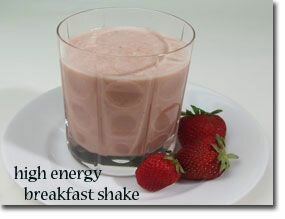healthy food tip and recipe
Today's Recipe
If you don't know what to serve for breakfast today ...
A quick-and-easy, nutritious and delicious addition to your Healthiest Way of Eating. And a great way to start the day!

Ingredients:
- 1 medium banana
- 1/2 cup whole strawberries
- 1-1/2 cup low-fat milk
- 2-1/2 TBS almond butter
- 2 TBS ground flaxseeds
- 1-1/2 TBS blackstrap molasses
- Blend all ingredients until smooth.
In-Depth Nutritional Profile for High Energy Breakfast Shake
Healthy Food Tip
Is it true that cabbage loses its
health-promoting sulfur compounds six hours after it is cut? How long
after it is cooked will cabbage lose its sulfur compounds?
Cabbage does not lose all of its sulfur compounds six hours after
being cut, nor does it lose all of its sulfur compounds after being
cooked. Much of the sulfur in cabbage and other foods is attached either
to proteins or related compounds, and this attachment prevents it from
being lost completely. There are several dozen sulfur-containing
derivatives of the amino acid cysteine found in cabbage and an
equivalent number of associated sulfoxides as well. Other
sulfur-containing (thiol) molecules are formed when cabbage is cooked.
While some of these compounds are definitely volatile and lost during
cooking, or over time after the cabbage has been chopped, not all are
removed.
In addition, the cutting process may actually increase certain health benefits since some of the newly formed (and transformed) sulfur-containing molecules have been shown to have cancer-preventive properties. This includes the sulfur-containing glucosinolates, which are formed when an enzyme called myrosinase is activated. Because the cutting and chopping of the cabbage is an event that activates myrosinase enzymes, it's actually helpful to let your chopped cabbage sit for a few minutes before cooking it (if you are planning to cook it). This time period will let the myrosinase enzymes convert some of the original sulfur-containing molecules in cabbage into glucosinolates. If you cook your chopped cabbage immediately after chopping, the heat will denature the myrosinase enzymes and the sulfur-containing glucosinolates will be unable to form.
I haven't seen studies showing the rate of sulfur-related changes in cooked cabbage over time. Nor have I seen studies showing sulfur-related changes in chopped raw cabbage. It's the antioxidant nutrient loss-and particularly the vitamin C loss-that shows up as most time-sensitive in both chopped raw cabbage and chopped cooked cabbage. Overcooking vegetables, including cabbage, is one of the best ways I know to rob vegetables of their nutrient benefits; when it comes to cabbage this includes its sulfur-related benefits. I recommend about five minutes (at most) for the steaming or "Healthy Sautéing" of raw cabbage. Prior to cooking, I recommend about the five-minute waiting period to allow sulfur-related changes to occur in the freshly chopped cabbage.
Virtually all types of cabbage will store safely in the refrigerator in whole-head form for at least one week. But a partly chopped cabbage head should be tightly covered and kept for no more than three to five days. Many raw cabbage recipes will contain either vinegar or lemon juice and these acidic liquids will help preserve the refrigerated cabbage-containing recipe over a period of several days. For optimal health benefits, however, I recommend enjoying a raw cabbage dish as soon as possible after it has been prepared.
For more information on this topic, please see:
References:
Rossner J, Kubec R, Velisek J, et al. Formation of aldehydes from S-
alk(en)ylcysteines and their sulfoxides. Eur Food Res Technol. 2004;215(2):1438-2377.
Rungapamestry V, Duncan AJ, Fuller Z, et al. Changes in glucosinolate concentrations, myrosinase activity, and production of metabolites of glucosinolates in cabbage (Brassica oleracea Var. capitata) cooked for different durations. J Agric Food Chem. 2006;54(20):7628-34.
Verkerk R, Dekker M. Glucosinolates and myrosinase activity in red cabbage (Brassica oleracea L. var. Capitata f. rubra DC.) after various microwave treatments. J Agric Food Chem. 2004;52(24):7318-23.
West LG, Meyer KA, Balch BA, et al. Glucoraphanin and 4-hydroxyglucobrassicin contents in seeds of 59 cultivars of broccoli, raab, kohlrabi, radish, cauliflower, brussels sprouts, kale, and cabbage. J Agric Food Chem. 2004;52(4):916-26.



No comments:
Post a Comment